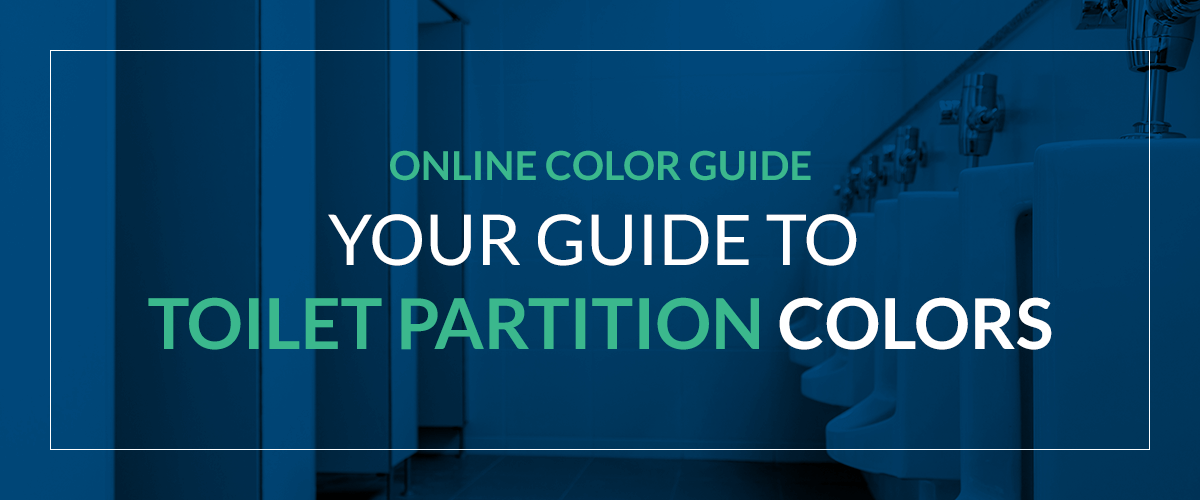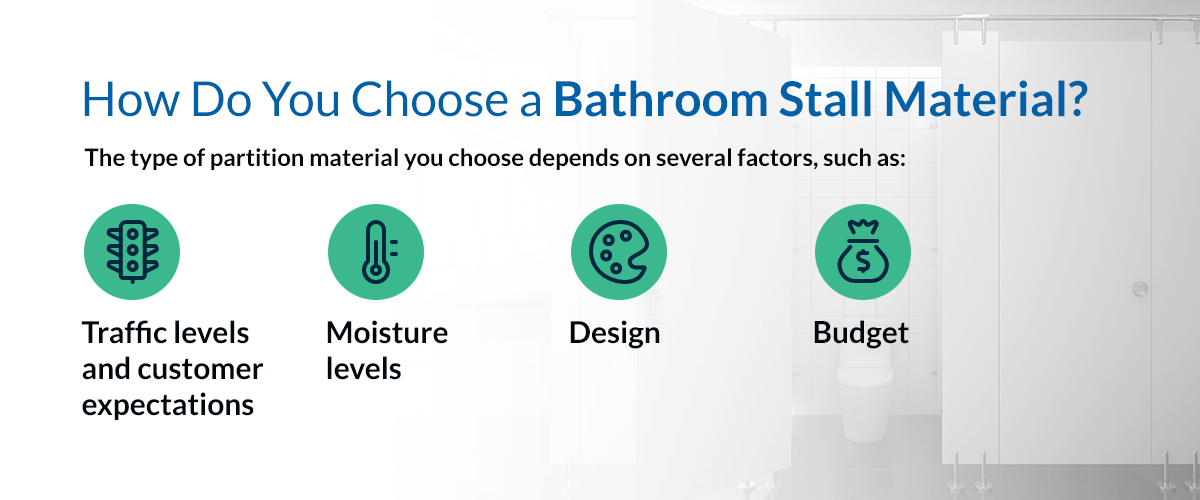What's the lead-time for partition delivery?
Enter your zip code and find out!

If you’re a business owner, chances are that you have a lot more to think about than bathroom partition colors. However, the details matter to your customers, especially when it comes to restroom cleanliness and comfort. Studies have shown that consumers are willing to spend more time and money at businesses that have clean, pleasant and well-maintained bathrooms. They’ll even choose a company over another if it offers a better restroom experience. Many consumers will not return to a business if the bathroom does not meet their expectations, and they won’t hesitate to tell friends and family about their experience — which can impact sales.
An attractive, clean bathroom also makes a difference for employees. Employees feel more appreciated when the restrooms are taken care of and were thoughtfully designed. A dirty, poorly maintained bathroom, on the other hand, makes employees feel like they aren’t valued. As most business owners know, that’s not a way to raise morale.
Fortunately, you don’t have to completely renovate your bathroom to make a great impression on employees and customers. With a few simple, affordable changes, you can make your business’s bathroom look and feel like new.
One way to improve your restroom is to upgrade its partitions. You can choose durable, easy-to-clean partitions in an attractive color that fits the bathroom’s overall design. By doing so, you’ll add comfort, privacy and aesthetic appeal, and create a more pleasant bathroom experience overall.
How do you choose the right bathroom stall color and material for your restroom? That’s what this guide is all about. In this guide, we’ll cover topics such as:
If you have any questions as you read this guide, reach out to us at One Point Partitions. Our design experts are here to help you make the best choice and find durable, appealing, American-made partitions for your bathroom.
Public restrooms trace back to Ancient Rome, but bathrooms were much less pleasant and private back then.Using a Roman public bathroom could be a terrifying experience, as users were afraid of being bitten by creatures lurking in the sewer channels or getting burned by flames due to methane buildup. They didn’t have any privacy either and sat right next to their neighbors as they used the facility.
Modern-day bathroom users have it made by comparison because partitions keep toilets separate and private. Business owners can further enhance the bathroom experience for their customers by selecting a quality partition material and attractive design.
In this chapter, we’ll explore different bathroom partition materials. We’ll also help you choose a material and color that’s suitable for your business. If you need any assistance along the way, we’re here for you at One Point Partitions.
A toilet partition is a metal or plastic divider that separates toilets in public restrooms. The purpose of a toilet partition is to provide privacy and comfort for the person using the bathroom stall, as well as protect their belongings from theft. It helps customers feel secure as they use the facility, which is a big plus for business owners.
Toilet partitions have been used in public restrooms for over a hundred years. Architect Frank Lloyd Wright is credited with being a partition pioneer for having designed the innovative restrooms of the Larkin Building in Buffalo, New York, which was built in 1903. His new suspended partitions and wall-mounted toilets made it easier to mop the floors. In 1918, an inventor was granted a patent for metal toilet partitions.
Today, business owners face a wide range of bathroom stall materials and colors to choose from. Proprietors can easily find partitions that suit their durability needs, budget and desired look.
Partitions are constructed from a range of materials. Some materials are designed to withstand frequent use and varying moisture levels. Here’s an overview of partition materials you can count on:
Bathroom partition heights vary, but generally, they are around 58 inches tall, or approximately 4 feet and 8 inches. Partitions are usually installed a foot off the ground, which brings the height closer to 70 inches. If you wish for greater privacy, you might choose partitions that measure 64 or 72 inches high. Please contact us at One Point Partitions to discuss height options and custom designs.

The type of partition material you choose depends on several factors, such as:
Your new bathroom partitions will be a major element in your restroom. They can potentially add an energizing pop of color to the space, or, if you’re going for a more tranquil setting, can help create a sense of calm. Either way, you’ll want to select the color carefully, because your customers will notice if the bathroom stalls don’t seem to fit with the overall look. They’ll also see if the bathroom has been carefully designed and looks stunning. Here are factors to consider:
Color psychology is basically the study of how different hues affect mood. For example, the color red is thought to stimulate appetite, which is why it’s a popular choice in restaurants. Blue, on the other hand, is associated with relaxation and is a popular shade for bathrooms and bedrooms. While you don’t need to be a color psychology expert to choose a suitable partition, it’s something you may want to consider. Here are a few different colors and their corresponding messages:
Before you make any decisions, think about the colors already present in your restroom. As a general rule, you’ll want to balance neutral colors, such as beige, gray, ivory or black, with vibrant hues. For example, if your bathroom walls are gray, you might choose red partitions to make the room more stimulating.
If you stick to a neutral color scheme, which can create a soothing environment, you’ll want to balance light and dark to make the bathroom more interesting. You might refer to the color wheel to discover what colors go well together.
The key to creating a well-designed bathroom is not to go overboard with color. Too much color can make the restroom feel overstimulating. That doesn’t mean you can’t hang artwork on the walls. It merely means you’ll want to think twice about adding red partitions if you have purple walls and yellow floors. In such an example, it might be better to choose black partitions.
In general, aim to include no more than three different colors in your bathroom. Choose one neutral color as the primary hue, which may be the wall paint. Then add a stronger shade, which would be the second most abundant color in the bathroom, or in this case, the partitions. Lastly, choose an accent color, which should be the most vibrant of all the shades in the room, but also used in the smallest amounts. This might be found in the artwork or other decor elements.
You can use this rule to combine neutrals in different ways, too, in case you don’t want to add anything extreme to your restroom. For example, a bathroom with soft green walls, wood-patterned partitions and gray tile floors uses all neutrals but is stunning nonetheless.
How busy does your bathroom get, and how often is it cleaned? You’ll want to think about maintenance requirements when selecting a partition color because some hues hide dirt better than others. For example, even though white can make a bathroom feel clean, it also shows dirt more easily. So, if you choose white partitions, make sure an employee is available to wipe it down periodically throughout the day, especially if your bathroom sees a lot of traffic. Darker shades or patterns are better at concealing dirt and stains and might be the best choice for high-traffic restrooms.
Consider the type of business you own and the message you want to send customers when choosing a partition color. For example, if you want to convey luxury and elegance, choose dark shades or stainless steel. If your business encourages creativity, think about choosing bright, playful colors or patterns. Your bathroom should fit in with the overall look of your building’s interior and be consistent with the mood.
How big is your restroom? Generally, it’s better to use light colors in smaller bathrooms. This is because light colors are more reflective than darker shades and can make a room feel more open. On the other hand, if you have a large restroom, you have more freedom to experiment with dark colors.
Need some assistance with your bathroom ideas? Use our online bathroom partition layout program to get started with a new design.